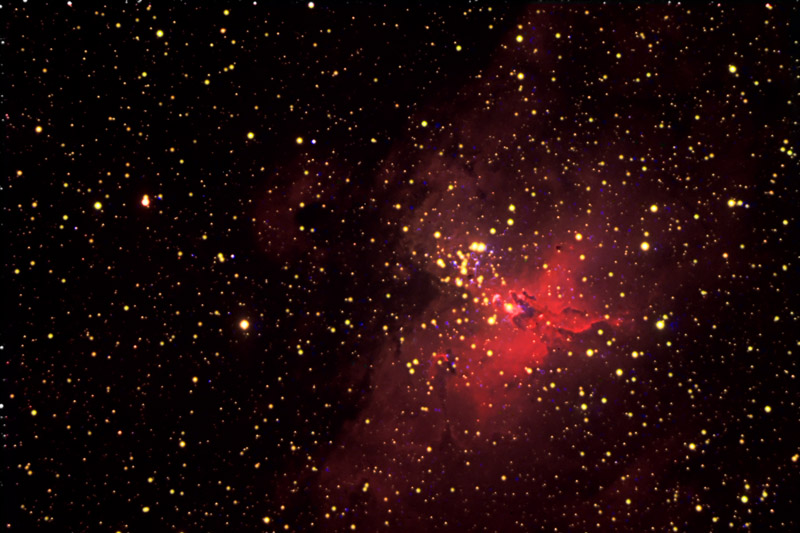M16 (NGC6611), the Eagle Nebula is both an open star cluster and a large bright area of emission nebulosity. It is located in the constellation Serpens Cauda. Within M16 are several star forming regions, including the "Pillars of Creation" made famous by the Hubble Space Telescope image. This structure, in the center of the image, is more than 6 light years from end to end. M16 is about 7,000 light years away from Earth.

This is the first image with our new TMB-130SS telescope, and is the culmination of a lot of work getting it set up. Any new equipment requires some installation and setup, but this job was made more difficult because a stroke 2½ months earlier left me without the use of my left hand (by 2009 I had recovered about 90% functionality, thanks to therapy and exercise). Louise and daughter Miranda helped with the heavy lifting, and we got the telescope installed on the G-11 mount, and the guide scope on top of the OTA.
Then it was up to me to align the finder scope with the main OTA so I could build a pointing model in the mount. This proved to be more tricky than I had imagined, because the FOV of the camera is fairly small, so I wasn't sure I was pointing at the target stars. But ultimately I succeeded. The next challenge was focusing. This was more difficult than normal because I didn't yet have a motor for the Feather Touch focuser, and couldn't focus under computer control. So all focusing was done manually, with me peering intently at the computer monitor six feet away as I turned the focus knob (if you think that's hard, consider that I focused the guide scope by sliding the camera back and forth on the dovetail rail while looking at the computer monitor, then using an Allen wrench to tighten the locking bolt on the mounting bracket at best focus — all using only one hand).
There were two major reasons for buying this telescope – a larger image scale and a more solid guide scope arrangement. With an image scale of about 2 arc seconds per pixel (versus 1.08 with the previous C9.25 SCT, guiding imperfections are less noticeable. The mounting rings allowed me to install a dovetail rail on top of the scope, and attach the guide scope and camera there. But this wasn't good enough – read why here.
| Exposure |
|
||||||||
| Processing |
Dark and flat-frame processing in CCDStack Statistical-combined in CCDStack Levels and curves in Photoshop CS2 |
||||||||
| Date and Location |
September 4, 2007
Montpelier, Virginia, USA |
||||||||
|
Equipment |
TMB-130SS APO refractor at f/7 on a Losmandy G-11 equatorial mount SBIG ST-8XM camera SBIG CFW-10 filter wheel with Astrodon filters Guide scope: 60mm f/5 refractor and ST-402 camera Imaging and autoguiding with MaxIm DL 4.57 |
Updated May 23, 2023